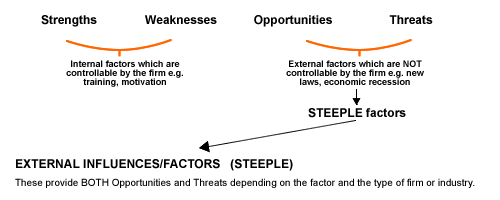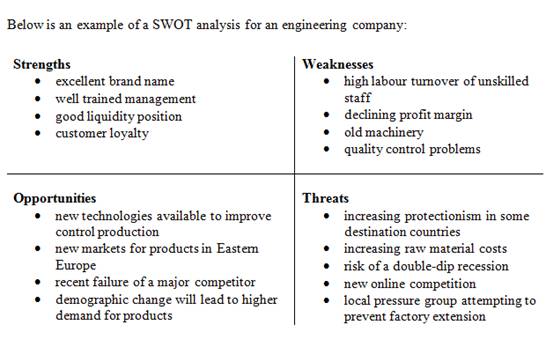to rearrange component ideas into a new whole and make judgments based on evidence or a set of criteria. Compare
Compare and contrast, Contrast, Discuss, Evaluate, Examine, Justify, Recommend, To what extent
AO4 You need to be able to Demonstrate a variety of appropriate skills. Command Terms These terms require you to demonstrate the selection and use of subject-specific skills and techniques: Annotate, Calculate, Complete, Construct, Determine, Draw, Identify, Label, Plot, Prepare
SWOT analysis
A SWOT analysis is an INTERNAL audit of where the business is at the present and how it is affected by its EXTERNALenvironmen (ie internal and external analysis):
The letters SWOT stand for:
STRENGTHS - what the firm does well and its advantages e.g. experience
WEAKNESSES - what the firm does not do well e.g. customer service
OPPORTUNITIES - changes in external conditions, which will allow the firm to develop markets, sell more, expand and make more profits
THREATS - External factors which may stop the firm achieving its aims - CONSTRAINTS and barriers
These are summarised in the diagram below:

As seen from the diagram, SWOT analysis should be combined with STEEPLE Analysis, which will provide more details of the external environment.
Why use SWOT analysis?
A SWOT analysis can support effective strategic planning based on an
examination of the firm's capabilities and its external environment. It
is mainly used to assess where a business is right now - business audit.
Its simple four box format makes it a useful visual tool to assist the planning process. The strengths and weaknesses are summary of the present position of the product, decision or organisation, whereas the opportunities and threats represent opportunities for growth or concerns about future threats to the business.


SWOT analysis has many uses and purposes.
- It gives a good picture of the firm's actual position in the marketplace
- It is a good training tool for staff and may help create a team environment.
- It helps develop a better understanding of the firm's service level, product range and brands
- It forces the firm to examine its business and consider the present and future competition.
- It examines external influences and future changes
- It encourages an assessment of strategic opportunities, such as expansion or relocation
There are links between:
- Strengths and Opportunities, and
- Weaknesses and Threats.
For example, a firm that has a well trained and loyal workforce (strengths) will be in a good position to adapt to changes in the markets (opportunities) and to produce products and services to meet new customer needs. So firms should seek to build on their strengths to put them in a position to take advantage of new opportunities when they arise.
However, a firm which has an unmotivated workforce and poor quality services (weaknesses) may not be in a good position to compete with new suppliers in the market place (threats). The firm should seek to reduce its weaknesses to address growing threats.
|
Opportunity for you
To begin your coursework
identify a business that will work with you and carry out a SWOT
analysis in an interview with one (or more) key decision makers. |
Limitations
Like any business tool it is only as good as the people
preparing and using it, and will need to be used in conjunction with
other tools. It requires honesty by all involved, especially to admit the organisation's weaknesses.
SWOT analysis should NOT be used to assess a strategy. You cannot have an opportunity or threat of a strategy.
 SWOT Analysis AO3, AO4
SWOT Analysis AO3, AO4